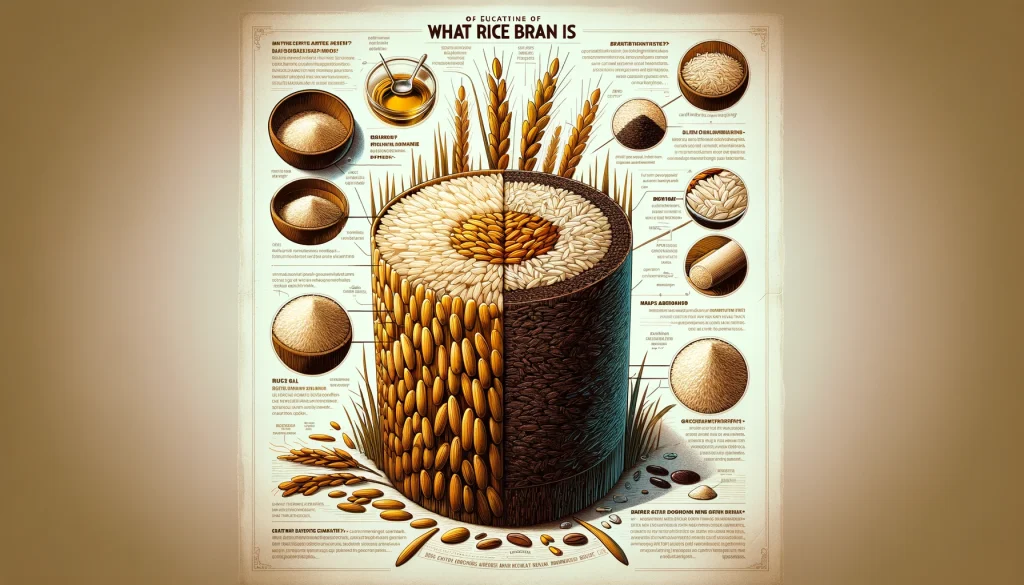As an Amazon Associate I earn from qualifying purchases.
Rice bran, the nutrient-rich outer layer of the rice kernel, often discarded during the milling process to produce white rice, has emerged as a hidden gem in the world of health and nutrition. Despite its humble origins as a by-product of rice processing, rice bran is a powerhouse of vitamins, minerals, essential fatty acids, and antioxidants, offering a spectrum of health benefits that are too significant to overlook. With an increasing focus on whole foods and natural supplements, rice bran has attracted attention not only for its nutritional value but also for its versatility in a variety of applications, from culinary uses to skin care and beyond. This article delves into the essence of rice bran, exploring its composition, health benefits, and the myriad ways it can enhance our well-being and contribute to sustainable practices in the food industry and agriculture. As we uncover the layers of rice bran’s potential, it becomes clear that this once-overlooked by-product is indeed a nutritional treasure waiting to be fully appreciated and utilized.
———
Table of Contents
———
…
What Is Rice Bran?

Rice bran is the nutrient-rich outer layer that surrounds the endosperm of whole grain rice kernels. This layer is removed during the milling process to produce white rice, leaving behind the brown rice grain. Rice bran is known for its high nutritional value, containing essential fatty acids, vitamins (notably vitamin E and B vitamins), minerals (such as magnesium, phosphorus, and iron), proteins, and dietary fiber. It is also a source of antioxidants, including gamma-oryzanol, which is believed to have various health benefits, such as reducing cholesterol levels and combating oxidative stress.
Because of its nutritional profile, rice bran is used in various applications beyond human consumption, including as a dietary supplement, in animal feed, and for extracting rice bran oil, which is valued both in the culinary world and for its potential health benefits. The utilization of rice bran contributes to the sustainable use of rice crops by ensuring that more parts of the harvested grain are put to productive use.
In addition to its use in dietary supplements, animal feed, and rice bran oil production, rice bran’s applications extend into other innovative and health-promoting areas:
Food Industry Uses
Rice bran is increasingly incorporated into a variety of food products to boost their nutritional value. It can be found in:
- Baked goods: Adding rice bran to bread, muffins, and other baked items enhances their fiber content and nutritional profile.
- Breakfast cereals: It’s used in cereals and granolas to increase dietary fiber and essential fatty acid content.
- Meat substitutes: Rice bran can be a component in vegetarian and vegan products, providing texture and nutrients.
Health Supplements
- Due to its rich nutrient content, especially antioxidants like gamma-oryzanol and vitamin E, rice bran is used in health supplements aimed at:
- Cholesterol management: Supplements containing rice bran or its derivatives may help in lowering bad LDL cholesterol.
- Antioxidant support: Its antioxidant properties make it a popular supplement for combating oxidative stress and supporting overall health.
Skin Care and Cosmetics
- Rice bran finds applications in the cosmetics industry, particularly in skin care products, because of its antioxidant and moisturizing properties:
- Moisturizers and serums: Rich in vitamin E and fatty acids, rice bran is used in products aimed at hydrating and nourishing the skin.
- Sunscreens: The natural antioxidants in rice bran can offer some protection against UV damage.
Environmental and Agricultural Innovation
- Biofuel production: Research into the use of rice bran as a biofuel source is ongoing, offering a potentially sustainable energy option.
- Soil amendment: In agriculture, rice bran can be used as a soil conditioner, improving soil health and fertility.
Nutraceuticals
Rice bran’s bioactive components are being explored for their potential nutraceutical properties, including:
- Anti-inflammatory effects: Components like gamma-oryzanol may reduce inflammation, offering benefits for conditions such as arthritis.
- Cancer prevention: The antioxidants and other compounds in rice bran are studied for their potential anti-cancer properties.
The versatility and nutritional value of rice bran make it a valuable resource across various industries. Its use not only enhances the nutritional content of products but also contributes to sustainable practices by utilizing what would otherwise be a waste product of the rice milling process. As research continues to uncover the full range of rice bran’s benefits, its applications are likely to expand even further.
Frequently Asked Questions (FAQ)
For those seeking to deepen their understanding of rice bran and its applications, here are some expert-level questions and answers that explore its characteristics, benefits, and uses:
Q: What exactly is rice bran?
A: Rice bran is the nutrient-rich outer layer of the rice grain, which is removed during the milling process to produce white rice. It contains a high concentration of vitamins, minerals, fatty acids, and antioxidants, making it a valuable by-product with numerous health benefits.
Q: What are the health benefits of rice bran?
A: Rice bran offers several health benefits due to its rich nutrient profile. It is a good source of dietary fiber, which aids in digestion and may help lower cholesterol levels. The antioxidants in rice bran, including vitamin E and gamma-oryzanol, can protect against oxidative stress and inflammation, potentially reducing the risk of chronic diseases. Its essential fatty acids contribute to heart health and skin vitality.
Q: How is rice bran used?
A: Rice bran has a wide range of applications. It’s used in the production of rice bran oil, a popular cooking oil. In the food industry, it’s added to cereals, baked goods, and other products to enhance their nutritional value. Rice bran is also used in animal feed, skin care products, and dietary supplements due to its health-promoting properties.
Q: Can rice bran be eaten as part of a regular diet?
A: Yes, rice bran can be incorporated into a regular diet. It can be added to smoothies, yogurt, baked goods, and other dishes to boost fiber intake and nutrient density. However, because of its high fiber content, it’s advisable to introduce it gradually to avoid digestive discomfort.
Q: Is rice bran oil healthy?
A: Rice bran oil is considered a healthy cooking oil option. It has a balanced composition of monounsaturated, polyunsaturated, and saturated fats. Its high smoke point makes it suitable for high-temperature cooking. The oil also retains many of the beneficial properties of rice bran, including antioxidants and nutrients that support heart health.
Q: Are there any side effects of consuming rice bran?
A: Rice bran is generally safe for most people when consumed in moderate amounts. However, because it’s high in dietary fiber, introducing it suddenly or in large quantities can lead to digestive issues such as bloating or gas. People with allergies to rice or other grains should also approach rice bran cautiously.
Q: How should rice bran be stored?
A: Rice bran should be stored in a cool, dry place, ideally in an airtight container to preserve its freshness and prevent it from becoming rancid. Because of its oil content, rice bran can spoil more quickly than other grain products.
Q: How does the nutrient profile of rice bran contribute to its health benefits?
A: Rice bran’s nutrient profile is exceptionally rich, comprising dietary fiber, essential fatty acids, vitamins (such as vitamin E complex and B vitamins), minerals (including magnesium, phosphorus, and iron), and antioxidants like gamma-oryzanol and ferulic acid. This composition contributes to various health benefits, such as supporting cardiovascular health by lowering cholesterol levels, providing antioxidant protection against cellular damage, enhancing immune function, and potentially reducing the risk of certain chronic diseases due to its anti-inflammatory properties.
Q: What makes gamma-oryzanol in rice bran particularly notable for health?
A: Gamma-oryzanol, a unique antioxidant found in rice bran, stands out for its multifaceted health benefits. It has been shown to lower cholesterol levels, exhibit anti-inflammatory effects, and potentially offer protective benefits against certain cancers. Gamma-oryzanol also contributes to improving athletic performance by influencing energy metabolism and muscle recovery. Its antioxidant properties further protect against oxidative stress, contributing to overall health and well-being.
Q: Can rice bran play a role in managing metabolic syndrome and diabetes?
A: Yes, rice bran can play a beneficial role in managing metabolic syndrome and diabetes. Its high dietary fiber content helps regulate blood sugar levels by slowing down glucose absorption and improving insulin sensitivity. The essential fatty acids and antioxidants in rice bran may also contribute to improved lipid profiles and reduced inflammation, addressing key components of metabolic syndrome. However, integrating rice bran into a diet should be part of a comprehensive approach to managing these conditions.
Q: How is rice bran utilized in the food industry, and what are the benefits?
A: In the food industry, rice bran is utilized to enrich products with its nutrient-dense profile. It is added to baked goods, cereals, and meat substitutes to increase dietary fiber, antioxidants, and essential nutrients. Rice bran is also used in the production of rice bran oil, a healthy cooking oil option. These applications not only enhance the nutritional value of food products but also contribute to waste reduction by utilizing a by-product of rice milling, supporting sustainability in food production.
Q: Discuss the role of rice bran in animal feed and its benefits.
A: Rice bran is a valuable component of animal feed due to its high nutritional content, including protein, fat, fiber, and minerals. When included in feed, rice bran can improve the growth and health of livestock and poultry by providing essential nutrients that support development and disease resistance. Its use in animal feed also aligns with sustainable agricultural practices by repurposing a by-product of rice processing, thereby reducing waste.
Rice bran’s versatility, coupled with its impressive nutrient profile, makes it a valuable resource across various sectors, including health supplements, food production, and animal husbandry. Its benefits extend from enhancing human health and nutrition to supporting sustainable and efficient agricultural practices, showcasing the broad potential of this often-overlooked by-product of rice milling.
Conclusion
In conclusion, rice bran stands as a testament to the hidden potential lying in the by-products of our food systems. Far from being just waste material, rice bran offers a rich tapestry of nutritional and health benefits, from heart health support and antioxidant protection to its role in managing cholesterol levels and enhancing digestive health. Its versatility extends beyond the health sector, finding its place in the culinary world, animal nutrition, and even in the beauty industry, showcasing its multifaceted utility.
The exploration of rice bran illuminates the importance of re-evaluating our approach to food production and consumption, highlighting the value of sustainability and the efficient use of resources. As we continue to seek ways to nourish our bodies and live in harmony with the planet, rice bran serves as a compelling example of how ingenuity and awareness can transform overlooked resources into vital components of our diets and industries.
Embracing rice bran in our daily lives, whether through dietary inclusion, as a health supplement, or in its oil form, can contribute significantly to our overall well-being. It also echoes a broader message about the treasures hidden in plain sight within our food supply, waiting to be discovered and appreciated. Rice bran’s journey from an underutilized by-product to a celebrated source of health and nutrition is a narrative of rediscovery and respect for the natural world’s bounty, encouraging a holistic view of health that integrates nutrition, sustainability, and global wellness.







